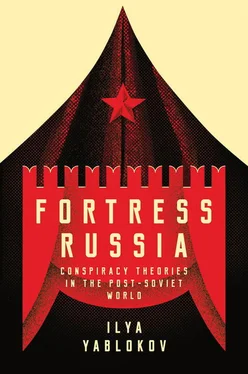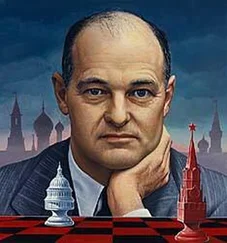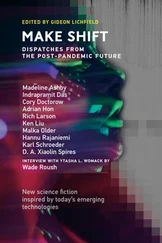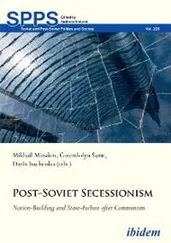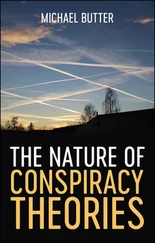The annexation of Crimea, and the application of international sanctions, did have negative consequences for the Russian political and economic elite, which had been well integrated into the global economy. Accordingly, some members of the elite voiced concern over the escalation of the Russia–West conflict and called for a peaceful solution (Sukhotin, 2014). Yet most members of the Russian establishment showed no sign of dissent and were strong supporters of the regime (Volkov, 2016). The conflict in Ukraine made the Kremlin hard-liners more powerful, and further isolation of Russia from the West would have been to their benefit (Krastev and Leonard, 2014). According to this paradigm, a retreat from the conflict, and the possibility of a peaceful solution, could have been seen by people like Dugin and Strelkov as a failure on the part of the hard-liners and a big climb-down in the conflict with the West.
Despite the blatant conspiratorial rhetoric which appeared throughout the media, genuine supporters of conspiracy theories do not play a major role in decision-making on important matters, unless their views benefit the Kremlin’s plans. Throughout this book, I have shown how the Russian elites use conspiratorial discourse as an instrument for securing support and legitimizing their actions. The Ukraine crisis is no exception: conspiracy theories have been applied by authorities tactically and instrumentally to achieve their goals. Yet while some members of Putin’s elite openly admit their belief in these theories, they rarely become the rationale of Kremlin policies. For example, Putin’s economic adviser, Sergei Glaz’ev, accuses the ‘small group of people in Putin’s government’ who devise the country’s economic policy of being agents of the West ‘serv[ing] the interests of banks and financial speculators’ (Adrianova, 2016). In retaliation, he proposes to isolate Russia from global financial markets and ensure that it does not use the US dollar in its transactions (Glaz’ev, 2016). Glaz’ev was allegedly involved in instigating public unrest in eastern Ukraine and the Crimea in 2014: at that point, his reputation as the pre-eminent anti-Western hawk was used to ensure public support of Kremlin policies in the rebellious Ukrainian regions of Donetsk and Luhanks and in Crimea (Meduza, 2016a). Yet, his radical economic views, which would arguably destroy Russia’s economy if they were actually implemented, seem too detached from reality even for the Kremlin. Accordingly, his advice remains on paper.
Seek and Destroy:
The Conspiratorial Legitimization of the New Laws
The crisis in Ukraine triggered another wave of repressions which furthered the authoritarian trend following the 2012 elections. In December 2013, amidst the growing conflict in Kyiv, Putin signed a law which criminalized calls for Russia’s disintegration (Meduza, 2016c). Putin’s later proposals for federalization in Ukraine and autonomy for Donbass backfired domestically. Similar movements reemerged in the Russian regions, such as Kuban’ and Novosibirsk, demanding more autonomy (Podrobnosti, 2014; TSN, 2014). These were perceived by conspiracy theorists as the subversive acts of Russia’s enemies, and Starikov’s followers called for the imprisonment of the people behind the movements. Putin’s remark that the Internet was a ‘CIA project’ (MacAskill, 2014) served to kick-start the Kremlin’s offensive against the Internet industry (Soldatov and Borogan, 2015). Putin’s aides, including Patrushev, regularly suggested that the Internet was used by Russia’s rivals to undermine the country’s statehood and therefore should be closely controlled (Kommersant, 2017).
The most conspiratorial of the new laws related, once again, to legislation on NGOs, which the Kremlin saw as instrumental in overthrowing the Yanukovich regime. Even though some changes to the law on NGOs took place shortly after Putin’s return to the Kremlin in 2012, another more recent cycle of repressive laws was justified by the escalation of the Ukraine crisis and the desire of politicians to protect Russia from ‘external threat’ by ‘undesirable organizations’ (Koshkin, 2015). The perception of foreign NGOs as a direct threat to internal security was the starting point for this new round of legislative amendments. Valentina Matveenko, Head of the Council of Federation which was formally behind the introduction of the new legislation, claimed unequivocally that the purpose of these organizations was to undermine the internal stability of the State and had brought coups d’etats in the countries where they had previous been active (i.e. Libya, Ukraine) (TASS, 2015).
Putin signed the law on so-called ‘undesirable organizations’ in May 2015. It granted the General Prosecutor’s office the right to close any foreign organization which the Russian authorities considered dangerous. One of the Duma deputies immediately requested that the Russian security services check out the Carnegie Foundation, Amnesty International, Human Rights Watch, Transparency International and Memorial Foundation (Makutina, Tagaeva and Khimshishvili, 2015). In June 2015, a member of the Council of the Federation introduced the so-called ‘patriotic stop-list’, which included twelve organizations that were mostly from the USA. The grounds on which organizations were to be included in the list were not clear; indeed, the senators pointed out that the information about the ‘subversive activities’ of these foundations had come ‘from undisclosed, but various sources’ (Korchenkova and Goriashko, 2015a). During the debates on the new law at the Council of the Federation in July 2015 it was revealed that the senators had consulted the General Prosecutor and the FSB before pushing the initiative forward (Bocharova, 2015).
The new media campaign against foreign foundations replicated the tactics which had been used during the periods when the anti-NGO legislation was first proposed in 2005, and when it was introduced in 2013. As in previous years it relied heavily on anti-Western conspiracy theories broadcast by the major television channels and pro-Kremlin experts. Starting from December 2014, Vesti Nedeli depicted these organizations as a major threat to internal security (see, for example, Kiseleva and Liadov, 2015). It paid particular attention to the National Endowment for Democracy (NED), a foundation closely related to the US Republican Party. This was the first of the American foundations to be banned in Russia under the new law. Even before the initiative was introduced in parliament, Russian television had started depicting this foundation as a cover for the CIA and a menace to domestic order. The first report provided by Vesti Nedeli in October 2014 covered a conference of the Russian opposition in Prague which was attended by representatives of the NED, and described the foundation as a major donor to opposition organizations in Ukraine, Libya and Syria, and as the ‘wallet’ of the State Department and Congress (Kiselev and Popov, 2014b). According to Vesti Nedeli , from 2014 the NED had begun to focus on Russia, and the Russian opposition came to Prague to present their ideas for ‘undermining’ the country from within. Furthermore, it went on to assert that the NED was behind all of the regime collapses which the Kremlin considered to have been successful over the past decade, such as Georgia, Ukraine, Libya and many others; that the techniques of ‘colour revolutions’ worked; and that these techniques were regularly implemented by the USA against its enemies.
Again, the similarities between the campaign against foundations in 2015 and the previous campaign against NGOs are striking. In the middle of the campaign against NGOs the Rossiia channel broadcast a two-hour talk-show and documentary entitled ‘Revolution on demand’, which was concerned with the ‘colour revolutions’ in Lithuania in 1991, Ukraine in 2014 and Macedonia in 2015. The presenter, Evgenii Popov, who had also reported on the NED meeting in Prague, focused on three events: the protests at the Vilnius television centre in Lithuania in January 1991, which were broken up by Soviet special forces; the Euromaidan protest in 2014; and the rallies against the Macedonian prime minister in Skopje in the summer of 2015. Popov portrayed them all as part of the same plan to extend US dominance around the world with the help of ‘colour revolutions’. The programme’s anchor, unequivocally following the conspiracists’ approach, pointed out, approvingly, that the documentary created the impression that all three revolts were all ‘one big event’, and illustrated this point by reference to the similarity of the technologies which were used in the protests in Lithuania, Ukraine and Macedonia (Spetsial’nyi korrespondent: Revolutsiia na zakaz, 2015).
Читать дальше
Конец ознакомительного отрывка
Купить книгу
